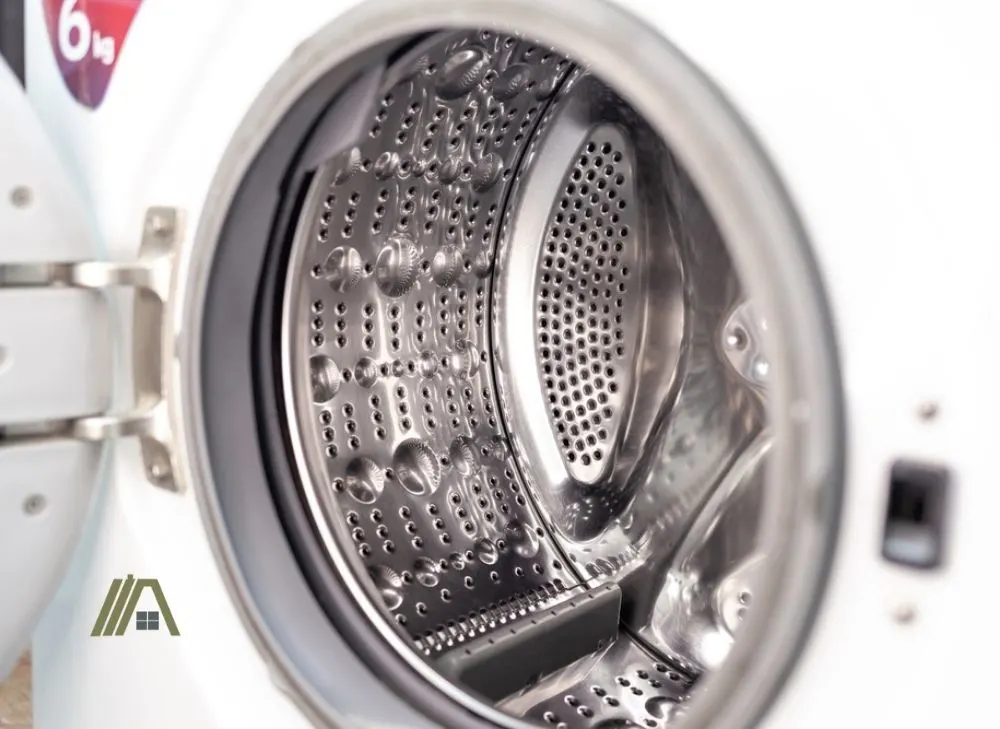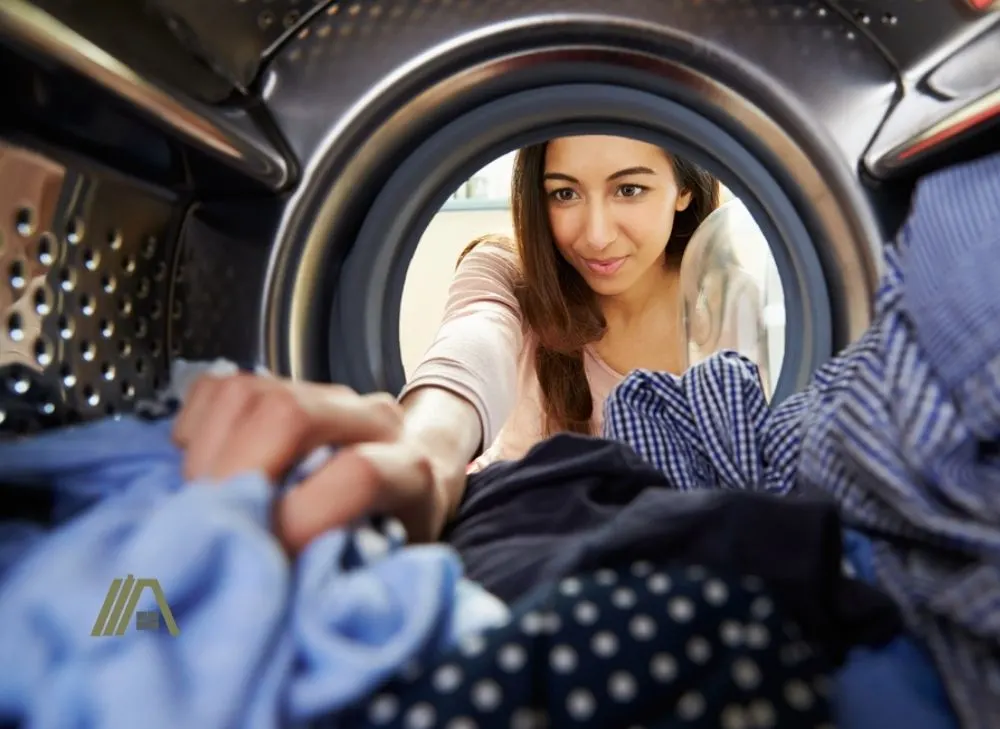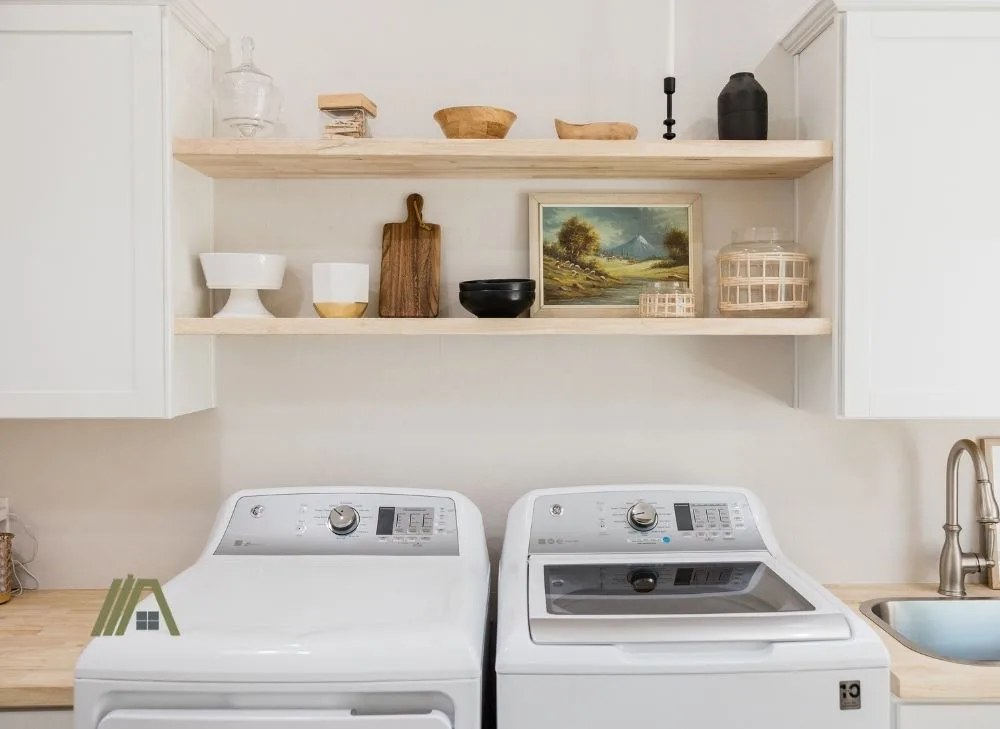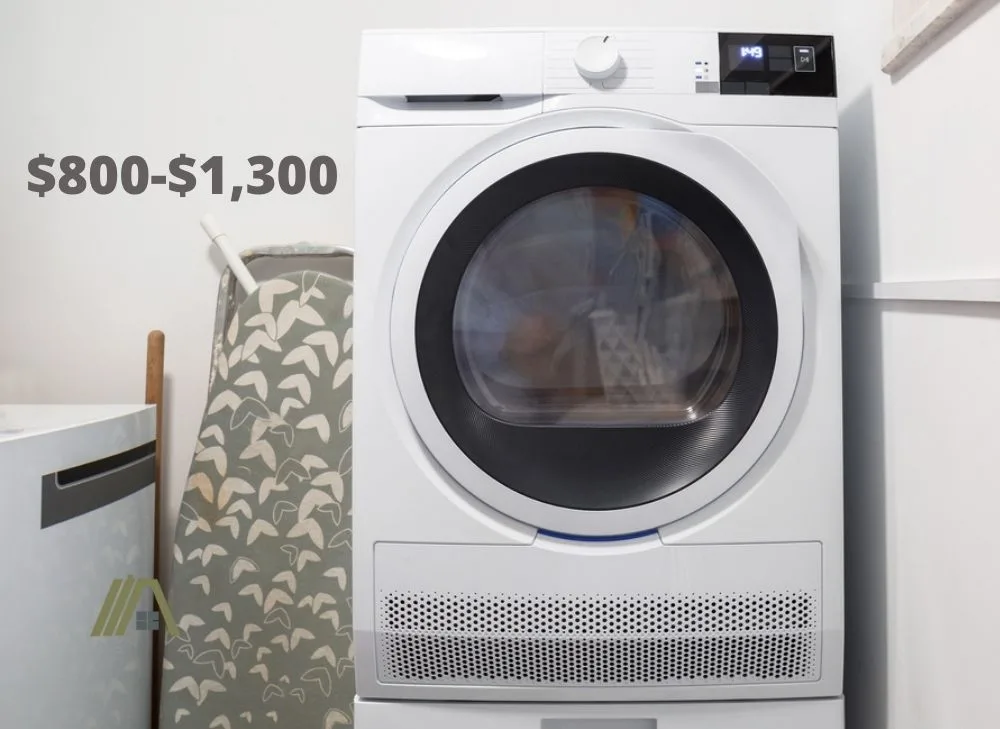
Condenser and heat pump dryers are both ventless. But condenser dryers use heating elements to heat air. Heat pump dryers use heat pump technology (refrigerant coils). Because of this difference, heat pump units cost more to buy but less to run, operate at lower temperatures, and are more energy-efficient.
Difference Between Condenser and Heat Pump Dryers: Overview
Both condenser and heat pump dryers are types of ventless dryers. Ventless dryers do not exhaust to the outdoors, but instead, condense and collect the moisture that is removed from clothing during the drying process.
Condenser dryers make use of a heating element to dry clothing, and a heat exchanger to condense the water that has evaporated from your clothes into the heated air.
Heat pump dryers, on the other hand, differ in that they use a refrigerant to catch and recycle heat within themselves, making them more energy-efficient.
What is a Condenser Dryer?
A condenser dryer is, as briefly covered, a type of ventless dryer. It runs by collecting the water from your laundry within itself, rather than expelling it as steam as a vented dryer would. Let’s take a look at how that works.

How Does a Condenser Dryer Work
A condenser dryer functions by making use of a heating element. The appliance pulls in air from the room and heats it using the heating elements. This hot air is blown through the drum, evaporating the water off of the clothing within.
The air then passes out of the drum and into an internal heat exchanger where it is cooled and the moisture condenses out of it into a collection tank or a drain.
The now cool and dry air passes over the heating element again and is re-heated and blown through the drum and the cycle continues until the dryer program finishes or is stopped.
Is Air Released into the Room?
Since condenser dryers are ventless, they don’t “release” air in the same way that a vented dryer would. Some heat may escape during the drying process, but you will primarily have air exit once the drying cycle is done and the doors are opened.
However, a condenser dryer does need to intake air during operation, so it should be placed inside your home with that in mind.
Elimination of Water
As mentioned, condenser dryers are able to cool the steam within the dryer with the use of a heat exchanger.
Depending on what model of dryer you have, this water is directed into a collection container that must be manually emptied after every cycle, or is drained straight out of the dryer through a hose.
Many models with a collection tray do allow the option of installing a drain hose.
Operational Temperature Range
Condenser dryers heat clothing much in the same way as traditional dryers, by making use of a heating element to evaporate water at a fast rate. Because of this, condenser dryers reach similar temperatures.
It is common for a condenser dryer to operate at around 158-167 °F (70-75 °C).
Average Purchase Cost
When searching for a condenser dryer, prices will often start at around $600 and reach up to around $1,100 depending on what models and brands you are looking at.
At these prices, a condenser dryer is pretty comparable to a traditional vented electric dryer when it comes to cost with the bonus of not having to pay for a ventilation system to be installed.
Approximate Running Costs per Cycle
Condenser dryers typically cost around the same as a vented dryer does to run.
Depending on what dryer models one is comparing, each condenser load might cost a few cents more or less than a vented load in terms of energy consumption.
Given that a typical vented electric dryer will cost around $0.53-$0.55 per load, you can expect a condenser dryer to sit at around the same cost.
Typical Drying Time
Condenser dryers are able to dry clothing at about the same rate as a traditional dryer, as they both create heat using a similar method in order to evaporate the water off of a load of laundry in large quantities.

In other words, a full load will typically take around 1 ½ – 2 hours to dry.
I do want to mention here that, if anything, users report that their condenser dryers take longer to dry than the vented models they have had in the past. It will depend largely on the dryer models that you are comparing.
Load Capacity Range
Condenser dryers tend to run on the smaller side. Many condenser dryers have a capacity of 3-6 cubic feet.
Larger condenser dryers do exist, but are often on the more expensive side and may take longer to dry full loads.
What is a Heat Pump Dryer?
A heat pump dryer is the other type of ventless dryer. It is technically also a “condenser” dryer, since it also condenses and collects the steam that evaporates off your laundry by cooling it back into a liquid state.
However, heat pump dryers utilize heat pump technology, which both explains the name and is a very different process than the condenser dryers we have already discussed.
How Does a Heat Pump Dryer Work
Heat pump dryers work by making use of closed-system heat pump technology instead of a heating element.

Air is pulled into the dryer from the room and passes over condenser coils filled with compressed, and therefore hot, refrigerant. The heat from the compressed liquid is transferred to the air that is then blown through the drum to evaporate moisture from the fabrics within.
Air is collected from within the dryer and pushed through a series of lint filters that remove lint and dust from the air.
The air continues moving through another device, called an evaporator, that cools it using heat exchange with the uncompressed, and therefore cool, refrigerant. In the evaporator, moisture is removed and collected. Finally, the air then passes back over the condenser coils, heating up to begin the cycle again.
Because heat pump dryers recycle the same air and collect moisture within themselves, there is no need to vent moist air outdoors, and because they use a heat pump system to cool and heat the air, no continuous energy input is required. This also enables heat pump dryers to be very energy-efficient.
Is Air Released into the Room?
Heat pump dryers do not typically release much air into the room during operation, given that they rely heavily on being a closed system in order to run. While some small amounts of air may escape through cracks, it is a very marginal amount.
Of course, any remaining heated or cooled air will also escape at the end of the drying cycle once the door is opened, just like with a condenser dryer.
Elimination of Water
As the air cycles through a heat pump dryer, it passes through an evaporator that removes moisture before being blown back into the drum to repeat the cycle. But where does this water go?
Much like a regular condenser dryer, this water can either be collected in a container that must be manually dumped out, or it is drained through a hose.
Many models come with both a collection container and the option to install a drain hose, so you can choose which method of water removal best suits you.
Operational Temperature Range
Heat pump dryers do not tend to get as hot as other types of dryers. They remove the water from your clothing bit by bit, purifying and re-using the same air in cycles rather than heating up and evaporating large amounts of water at once.
Where condenser dryers tend to reach around 158 °F (70 °C), a heat pump dryer tends to run at around 122 °F (50 °C).
Average Purchase Cost
On average, a heat pump dryer will cost around $200-400 more than a condenser dryer or a traditional electric dryer when purchasing upfront.
This means you can expect to find heat pump dryers for about $800-1,300. While this seems expensive, they may save you money in the long run due to their energy efficiency.

Approximate Running Costs per Cycle
Heat pump dryers are currently the most energy-efficient dryers on the market.
Depending on what kinds of dryer and what models you are comparing, a heat pump dryer can be up to 50% more energy efficient!
While the number will differ according to your own usage, an average load of laundry costs $0.17-$0.33 in a heat pump dryer, compared to $0.53-$0.55 in a condenser dryer.
Typical Drying Time
Again, heat pump dryers don’t typically reach very high temperatures compared to other dryer types. They take around 30 minutes to reach running temperature, and remove moisture using a slower process.
Compared to the 1-2 hours a typical electric dryer might take, a heat pump dryer can take about 2½ – 3 hours to dry a full load.
This is both a benefit in that lower temperatures are gentler on your clothing and will help it last longer, but this is also a negative if you are someone who prefers a fast dry.
Load Capacity Range
Most heat pump dryers are able to handle a smaller load capacity than average, between 3 and 6 cubic feet depending on the model. This is comparable to condenser dryers.
There are larger models of heat pump dryers that can reach larger capacities comparable to vented units. However, the trade-off is often drying times that sit on the longer end, and of course, a higher price tag.
Table of Differences Between Condenser and Heat Pump Dryers
| Condenser Dryers | Heat Pump Dryers |
| Uses a heating element and a heat exchanger to operate | Uses heat pump technology to create and recycle heat within itself |
| Does not release significant amounts of air | Does not release significant amounts of air |
| Collects water in a container to be manually emptied, or can automatically drain using a hose | Collects water in a container to be manually emptied, or can automatically drain using a hose |
| Runs at around 158-167 °F (70-75 °C) | Runs at around 122 °F (50 °C) |
| Average cost around $600-$1,100 | Average cost around $800-$1,300 |
| Costs around $0.53-$0.55 per load (comparable to vented electric dryer) | Costs around $0.17-$0.33 per load |
| Takes around 1½ – 2 hours to dry (comparable to vented electric dryer) | Takes around 2½ – 3 hours to dry |
| Usually 3-6 cubic feet depending on model (smaller than average) | Usually 3-6 cubic feet depending on model (smaller than average) |
Should I Get a Condenser Dryer or Heat Pump Dryer?
As with most things, the type of dryer you decide to get should be determined by your individual needs and wants. Depending on certain aspects of your lifestyle, one type of dryer may work better for you than another.
If you’re looking at ventless dryers because you heard they were cheaper or more environmentally friendly, you’d probably want to take another look at heat pump dryers. That is, if you don’t mind shelling out the extra cash upfront!
On the other hand, if you’re simply looking at ventless dryers because a vented dryer won’t work with your living situation, or if you prefer the convenience of fast-operating appliances, you may prefer the condenser dryer.
Lastly, you’ll want to consider that ventless dryers are typically smaller than vented dryers in general.
While the smaller size of ventless dryers is convenient for some, it could be a problem for you if you have a large family or are simply someone who often has laundry to do.
If that’s the case, and vented dryers are an option in your living space, you may want to take a look at the differences between vented and ventless dryers as a whole.
Sources
https://www.albertlee.biz/blog/Guide-get-pumped-about-heat-pump-dryers
https://www.beko.co.uk/support/faqs/tumble-dryers/differences-between-heat-pump-and-condenser-dryer
https://aeg-appliances.ca/condensation-dryers-explained/
https://www.attainablehome.com/what-are-heat-pump-dryers-are-they-worth-it/
https://www.cnet.com/home/kitchen-and-household/how-to-buy-the-best-dryer-in-2020/
https://www.coolblue.nl/en/advice/heat-pump-dryer-or-condenser-dryer.html
https://www.greenbuildingadvisor.com/article/heat-pump-clothes-dryers
https://www.stellisonselectrical.co.uk/blog/post/what-is-a-heat-pump-tumble-dryer
https://www.thisoldhouse.com/21097178/exploring-a-heat-pump-clothes-dryer
https://www.youtube.com/watch?v=5wmFoWOujZ8
https://www.whirlpool.com/blog/washers-and-dryers/what-is-a-ventless-dryer.html
https://zeroenergyproject.org/2021/01/08/heat-pump-clothes-dryers-ready-for-prime-time/
